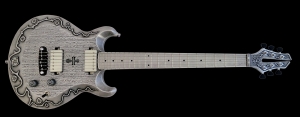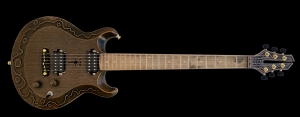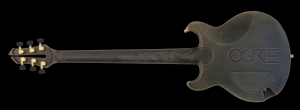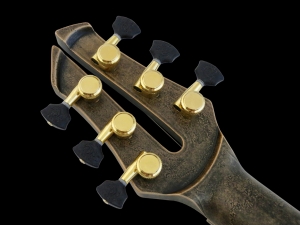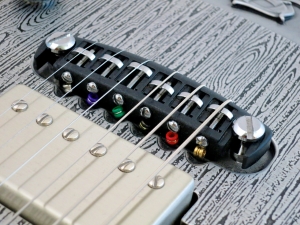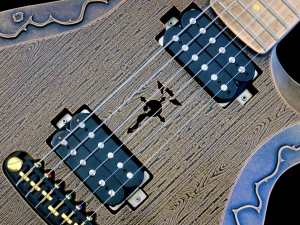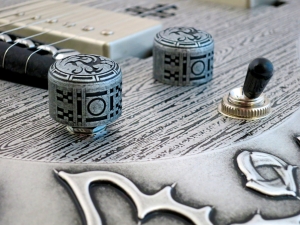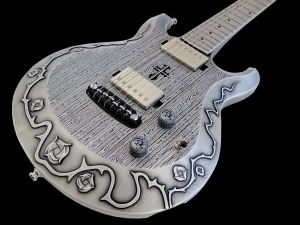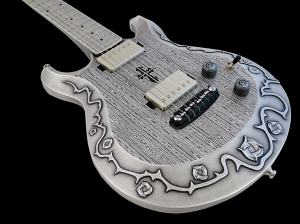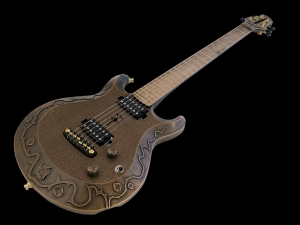Lisätiedot: EM Nordic
Review: Tokai Classic Series
Tokai Guitars has built its reputation on very well-crafted and vintage-correct copies of classic models. The original Japanese Tokai instruments from the Seventies and Eighties gave most US manufacturers a good run for their money, and in some respects Tokai’s – ahem – ”versions” were even better than some of the originals from that era.
Tokai’s top-of-the-line instruments are still made in Japan. The company’s Chinese output, though, makes it possible to own a genuine Tokai guitar (or bass), even on a tighter budget.
The idea behind the brand-new Tokai Classic series is to offer very reasonably priced guitars and basses, which combine a classic look with a few modern tweaks for easier playability.
****
Kitarablogi received these three Tokai Classics for review:
A Tokai Classic TE (current price in Finland: 249 €) in a 50s-style two-tone sunburst finish…
…a creamy white Tokai Classic ST (249 €)…
…as well as a Classic JB bass (299 €) in a fetching three-tone sunburst.
Tokai’s Classic series features bolt-on maple necks.
On the TE and ST models the face of the headstock sports a gloss finish.
The JB bass’ headstock front has received the same thin satin finish as the neck.
All Classic instruments offer easy access to the truss rod at the headstock, so you won’t have to take off the neck to make adjustments.
There’s a set of very decent Kluson-copies installed on the guitars.
The Classic JB comes with a set of Schaller-copies, which are less massive than vintage-style Klusons.
The Classic TE and ST come with a flatter-than-vintage fingerboard radius and chunkier frets, which makes the playing feel much more modern and bend-friendly.
The same goes for the Tokai Classic bass.
All Classic series bodies are made of basswood, a proven tonewood with a sound similar to alder.
The black plastic cushion beneath the neck plate protects the finish.
There are different versions of the three-saddle Tele-style bridge in circulation:
The Classic TE goes for the late-Sixties variety sporting three saddles with pre-set grooves for the strings.
The TE came strung the regular way, though the body, with the strings’ ball-ends anchored in ferrules. This setup is favoured by most Tele players.
Tokai’s Classic TE nevertheless offers an additional interesting feature:
It’s possible to string this guitar through the back of the bridge, too. This was a rare feature on original Fender Telecasters in 1958/59 that noticeably alters the feel and sound of the guitar.
At first glance, the bridge on Tokai’s Classic ST looks like a dead-on copy of a vintage Strat vibrato.
The vibrato block, though, isn’t as chunky as on the original. It’s about the same size as the block on a Floyd Rose vibrato.
Vintage-anoraks will sniff disapprovingly at the sight of such a block, claiming that it’s bad for the tone of the guitar. Let me tell you that the review guitar’s acoustic ring and sustain were actually quite healthy. So much for preconceptions…
The Classic JB sports a nice copy of a 1970s Fender bass bridge.
Most self-appointed ”vintage-gurus” will tell you to steer clear at all times of ceramic Fender-style singlecoils.
Traditionally, a Fender-type singlecoil is constructed from six small, cylindrical magnets, which are tapped into vulcanised fibre plates. Around this magnet core a coil of thin copper wire is wound to complete the pickup. In traditional pickups the polepieces you see are actually the top ends of the alnico magnets.
Tokai’s Classic series uses ceramic pickups, which are made a little differently. The polepieces aren’t magnets, but rather soft steel rods, which are in physical contact to a ceramic bar magnet (or sometimes two magnets) stuck to the bottom of each pickup.
When ceramic pickups first appeared on budget guitars in the Nineties, their sound was admittedly often very spiky, brittle and sharp. This gave ceramic singlecoils a bad name, which wasn’t all that undeserved.
But that was then, and ceramic pickups have been improved drastically since. Despite this, there’s still quite a lot of prejudice against this type of guitar pickup.
In the case of these Tokai Classic instruments, I’d suggest you approach their pickups with an open heart and open ears – you might be in for a positive surprise!
The Classic series features electronic parts of inexpensive, but very decent quality. All the switches and controls work fine, and without any hiccups.
As you can easily see from this picture, the workmanship is very clean in the Classic TE.
The rout for the Classic JB’s component cavity wasn’t quite as clean on our review sample. Luckily, this has no bearing whatsoever on the functionality of this bass guitar.
****
Tokai’s Classic TE is a very nice, well-playing Tele-style electric guitar.
Quite often, you will find uninspiring, flat and generic neck profiles on instruments in this price bracket.
The Classic TE is quite an exception, as it sports a comfortable, well-rounded and chunky neck, that still manages to stay on the right side of ”fat”. The fretwork is really great on our review sample. Combined with the bigger frets and flatter fretboard radius, this results in a slinky and bend-friendly playing feel.
Tokai’s Classic TE is no slouch in the sound department, either:
The neck pickup is warm and round, but never sounds boring or one-dimensional. The middle position of the switch will give you a cool, funky rhythm tone. The bridge pickup on its own offers enough twang for Country playing, and enough whack for the Classic Rock crowd.
****
I’d never have thought an electric guitar costing only 249 € could be as utterly inspiring as this Tokai Classic ST!
The neck feels great with its oval C-profile. The fretwork and setup make this a real player’s guitar. The vibrato works well in a vintage-style way, and the ST’s acoustic tone is woody and dynamic.
The ceramic pickups on the Tokai Classic ST are a bit hotter than the alnicos on my 50s-style Fender Stratocaster reissue. They also have a bit more sizzle and bite, but in a good way, making this more of a ”Jimi Hendrix” than a ”Buddy Holly” guitar.
****
Tokai’s Classic JB truly offers a lot of bass in a very pocket-friendly package.
The Classic JB will give you all the features you’d look for in a Jazz Bass-type instrument:
There’s the slender, distinctly tapered neck profile, the comfortable balance, and the wide variety (for a passive bass) of different sounds.
This last clip lets you listen to the video’s bass and guitar tracks in isolation. During the first half all guitar tracks are played on the Classic TE, in the second half the Classic ST takes over:
****
Tokai’s Classic Series may well prove to set a new standard for vintage-style instruments in this price range. The three reviewed guitars were well-made, well-playing instruments, and their sound was inspiring.
While the Classic series is aimed mainly at beginners, I wouldn’t be surprised if some of the instruments crept up on pub or club stages!
****
Tokai Classic Series
Tokai Classic TE – 249 €
Tokai Classic ST – 249 €
Tokai Classic JB – 299 €
Finnish distributor: Musamaailma
****
Pros:
+ value-for-money
+ playability
+ workmanship
+ sound
Review: Ogre Guitars Magnox-M1
There was this strange booth at Frankfurt Musikmesse 2015 that had everybody stop and take notice:
A company called Ogre displayed a variety of very goth effect pedals, but the real show-stopper was a medieval-looking electric guitar made completely out of magnesium alloy, called the Magnox-M1.
Thanks to Finnish distributor R-Jam Group we were able to take a closer look at this intriguing new concept.
****
The all-metal Ogre Magnox-M1 (current price in Finland: 1,399 €) truly is a sight to behold. It isn’t often you get to see an instrument that looks like old metal, and which features beautiful rose-and-thorns reliefs on its body.
The twin-cutaway Ogre Magnox-M1 has a scale of 25.5 inches (64.8 cm), and its thin body is partly hollow.
Our two review instruments both come with a pair of humbuckers, but there’s also an HSS-loaded Magnox-M1 available.
The back of the body sports a deep ribcage bevel.
The output jack sits in its own recess.
The top nut is also made from magnesium alloy. Even though it looks a bit like a locking nut, the strings aren’t locked.
Ogre go for top-drawer quality in the tuner department by using Sperzel locking tuners equipped with Ogre’s own metal tuner buttons.
The pewter-coloured Magnox-M1 sports black dot markers.
The position markers on the bronze-coloured Ogre are golden.
The Magnox comes with 22 medium jumbo frets.
Ogre’s neck joint is very smooth, so you can widdle your way up to the dusty end with ease.
The wraparound bridge is Ogre’s own design, its base cast from the same metal alloy as the rest of the guitar.
Twin-humbucker equipped Magnox-M1 models are available with two different sets of pickups:
In our case, the pewter Ogre sports a pair of the company’s own PAF-style ’buckers.
The bronze-coloured Magnox comes with a Seymour Duncan ’59 at the neck, and a JB model at the bridge.
These Ogres are equipped with a three-way toggle switch, as well as master volume and tone controls. There’s a push/pull-switch hidden in the master tone control, which allows you to split the humbuckers for singlecoil tones.
A close look under the hood reveals quality parts and clean workmanship.
A fancy carbon fibre hard case is included in the price.
****
Thanks to its semi-hollow body the Ogre Magnox-M1 only weighs a very comfortable 3.8 kg. Despite the fact that the neck and fingerboard are not hollowed out, the M1 stays perfectly balanced .
Ogre’s expertise in the finishing department is really something else:
Both guitars look old, rusty, and oxidised, and some parts even look coarse and scratched, but this is all a very cool illusion conjured up by the excellent finishing job. In reality the Magnox-M1 feels very smooth and friendly, even if it’s a tad cool when pulled out of its case. The only things that are real are the beautiful reliefs on the front and back of the body (as well as on the control cavity lid), all other dings and scratches are an optical effect.
In my opinion Ogre’s not-too-chunky C-profiled neck feels really great. The fretwork is excellent, and the fretboard’s edges are comfortably smooth.
Ogre’s own PAF-style humbuckers have a very dynamic, crisp and open sound, thanks to their moderate output levels. The split-coil settings sound remarkably Fender-like.
The sound clips both feature the split humbuckers first, followed by the full humbucker settings, both starting with the neck pickup:
The Seymour Duncan set is higher in output, and the sounds have a fatter mid-range character. Played into a clean channel, the bridge humbucker can sound a bit honky at times, but using crunchy settings will make the JB model rock even harder than the Ogre bridge humbucker.
The sound clips both feature the split humbuckers first, followed by the full humbucker settings, both starting with the neck pickup:
The demo track features the pewter-hued Magnox-M1 exclusively for the first half, while all the guitar tracks in the second half have been played on the bronze Ogre model.
• rhythm guitars (split pickups) – left channel: both pickups, right channel: bridge pickup
• lead guitar – full neck humbucker
****
The Ogre Magnox-M1 is a very fine electric guitar, which offers a viable alternative to traditional wooden instruments. I really like the visual design of these guitars, too, but some might disagree. The best thing about the Magnox-M1 guitars, though, is the great sound they make. These are very inspiring instruments, indeed!
****
Ogre Magnox-M1
1.399 €
Finnish distributor: R-JAM Group
****
Pros:
+ cool design
+ workmanship
+ playability
+ different pickup options available
+ sound
Testipenkissä: Tokai Classic Series
Tokai Guitarsin maine perustuu firman erittäin laadukkaisiin ja tarkkoihin kopiosoittimiin. Japanilaisen Tokain ”versiot” klassikkosoittimista olivat 1970- ja 80-luvulla monessa suhteessa jopa parempia kuin saman aikakauden kitarat USA:sta.
Tokain parhaimpia sarjoja valmistetaan yhä Japanissa, pitkälti käsityönä. Firman kiinalaiset sarjat tarjoavat kuitenkin oivan mahdollisuuden omistaa aidon Tokai-kitaran tai -basson myös pienemmällä budjetilla.
Upouuden Tokai Classic -sarjan idea on tarjota edullisia soittimia, joissa vintage ulkonäköön on yhdistetty nykyaikainen soitettavuus.
****
Kitarablogi sai kolme Tokai Classic -sarjalaista testiin:
Tokai Classic TE:n (249 €) Two Tone Sunburst -viimeistelyllä…
…kermanvalkoisen Tokai Classic ST:n (249 €)…
…sekä Classic JB -basson (299 €) kolmivärisellä sunburst-värityksellä.
Tokai Classic -sarjan kaulat veistetään vaahterasta.
TE- ja ST-mallissa viritinlavan etupuoli on viimeistelty kiiltävällä lakalla.
Bassomallissa koko kaulassa on ohut mattaviimeistely.
Kaularaudan säätäminen tapahtuu Classic-soittimissa lavan puolelta, ilman kaulan irrottamisen tarvetta.
Kitaroissa käytetään hyviltä tuntuvia Kluson-kopioita.
Classic JB:n lapaan on asennettu pienempiä Schaller-tyylisiä vintage virittimiä.
Classic TE:n ja ST:n otelautojen vintagea loivempi radius, sekä kitaroiden nykyaikaiset medium jumbo -nauhat, tekevät soittotuntumasta hyvin mukavan, etenkin kielten venytyksissä.
Myös Tokai Classic -bassossa on sopivasti nykyaikainen soittotuntuma.
Classic-sarjojen kokopuiset rungot valmistetaan lehmuksesta.
Kaulalevyn alta löytyvä musta muovityyni suojaa soittimen viimeistelyä.
Tele-tyylisestä tallasta löytyy erilaisia versioita:
Classic TE:n tallassa on kolme tallapalaa, joissa on valmiiksi kieliuria.
TE:n kielet voi pujottaa rungon läpi, mikä on juuri se tapa, jota Tele-soittajat tavallisesti suosivat.
Tokai Classic TE:ssä on kuitenkin myös mahdollisuus kiinnittää kielet tallan takaseinään.
Se oli harvinainen ominaisuus vuoden 1958/59 Fender Teleissä, ja tämä kiinnitystapa muuttaa tuntuvasti kitaran soundia ja tatsia.
Tokai Classic ST:n talla näyttää edestä täydelliseltä vintage-vibran kopiolta.
Tallan metalliblokki on kuitenkin jonkin verran ohuempi kuin alkuperäisessä – se on hyvin samankaltainen kuin Floyd Rose -vibran blokki.
Vintage-hipsterit aloittaisivat blokin takia heti valittelun sen tuomasta ”huonosta” soundista, mutta ainakin testisoitimessa akustinen soundi ja kitaran sustain olivat hyvinkin kohdillaan.
Classic JB:n talla on hyvä kopio 1970-luvun Fender-tallasta.
Monet ”vintage-gurut” eivät koskaan koskisi sellaiseen Fender-tyyliseen soittimeen, jonka mikrofoneissa on alkuperäisestä poikkeava rakenne:
Perinteinen tapa rakentaa Fender-tyylinen mikrofoni on kiinnittää lieriömäisiä magneettipätkiä kahteen kuitulevyyn. Magneettirivin ympärille käämitään sitten mikin kela. Näissä perinteisissä mikrofoneissa näkyvät navat ovat mikrofonin magneetit.
Tokai Classic -sarjan soittimissa käytetään hieman edullisempia mikrofoneja, joissa on teräksisiä napapaloja, sekä mikkirungon alle liimattu keraaminen tankomagneetti (tai kaksi).
Kun nämä keraamiset mikrofonit ilmestyivät 1990-luvulla edullisissa soittimissa, niiden soundi oli eittämättä hirveän piikikäs ja korvia raastava. Mikkityyppi sai tästä (osittain oikeutetusti) huonon maineen.
Alkuajoista kehitys on kuitenkin mennyt hurjaa vauhtia eteenpäin, ja nykyisten edullisten keraamisten mikrofonien laatua on parannettu hyvin tuntuvasti.
Ainakin Tokai Classic -soittimien tapauksissa kannattaa lähestyä niiden mikrofoneja ennakkoluulottomasti.
Classic-sarjan elektroniikka on laadultaan mukavasti asiallinen – kaikki säätimet ja kytkimet toimivat moitteettomasti.
Testibasson elektroniikkakolossa työnjälki ei ollut ihan niin siisti kuin testikitaroissa. Tämä ei kuitenkaan vaikuta millään lailla soittimen toimivuuteen.
****
Tokai Classic TE on erittäin mukavan tuntuinen Tele-tyylinen sähkökitara.
Tämän hintaluokan soittimissa törmää melko usein sellaisiin kaulaprofiileihin, jotka tuntuvat kulmikkailta tai liian ohuilta.
Classic TE on tässä ilahduttava poikkeus, kitaran mukavan pyöreän ja lihaksikkaan kaulan ansiosta, joka ei kuitenkaan ole liian paksu. Myös TE:n nauhatyö on kiitettävällä tasolla.
Testisoittimen paino ja soitettavuus olivat siis kohdillaan, samoin kuin TE:n soundi:
Etumikrofoni on lämmin ja pyöreä, mutta kuitenkin eloisa, kytkimen keskiasennosta taas saadaan loistava Funk-soundi, ja tallamikrofonissa sekä Country-twäng että Rock-asenne ovat kohdallaan.
****
Miten vain 249 euroa maksava sähkökitara voi ollakin niin inspiroiva kuin tämä Classic ST?
Kaula tuntuu erittäin mukavalta (C-profiili), soittotuntuma on kevyt ja vaivaton, vibratalla toimii hyvin (vintage-tyylisissä raameissa), ja akustisessa soinnissa on kiitettävästi dynamiikkaa ja ”puuta”.
Tokai Classic ST:n keraamisissa mikit ovat hieman kuumemmat kuin esimerkiksi vertailussa käytetyssä, vintage-tyylisessa Stratossa. Mikkien soundissa on myös hiukan enemmän preesensalueen purevuutta – soundi on siis enemmän ”Jimi Hendrix” kuin ”Buddy Holly”.
****
Classic JB -bassokin tarjoaa paljon soundia hyvin kohtuuhintaisessa paketissa.
Tokai Classic JB tarjoaa kaikki ne ominaisuudet, joita vanha Jazz-basso fani soittimeltaan kaipaa:
Kaulaprofiili on mukavan solakka, soittimen balanssi on kohdallaan, ja basson tarjoama soundikirjo on passiivibassoksi laaja.
Viimeisessä klipissä soi videon biisin kitara- ja bassoraidat ilman muuta taustaa (ensimmäinen puolisko: TE; toinen: ST):
****
Tokai Classic -sarjasta voisi mielestäni helposti tulla uusi laatustandardi tämän hintaluokan soittimissa. Testisoittimissa laatu, soitettavuus ja soundi olivat enemmän kuin kohdillaan.
Vaikka Classic-soittimien kohderyhmä on selvästi aloittelijat, voi vanha kettukin saada paljon iloa näistä kitaroista ja bassoista!
****
Tokai Classic Series
Tokai Classic TE – 249 €
Tokai Classic ST – 249 €
Tokai Classic JB – 299 €
Maahantuoja: Musamaailma
****
Plussat:
+ hinta-laatu-suhde
+ soitettavuus
+ työnjälki
+ soundi
Guitar Porn: ESP LTD MM-30
ESP LTD MM-30 on Musamaailman 30-vuotis juhlamalli.













































